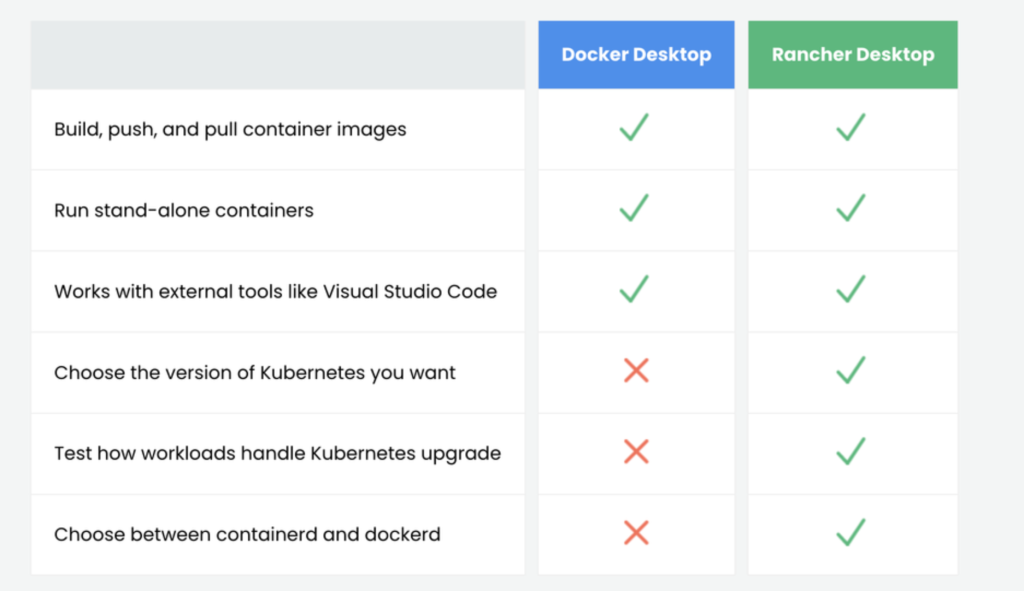
When comparing Docker Desktop vs Rancher Desktop, especially in 2025 with Apple Silicon, open-source trends, and license changes in mind, it’s important to break down all key differences, similarities, and potential alternatives in a clear, structured way.
 Docker Desktop vs Rancher Desktop – Comprehensive Comparison (2025 Edition)
Docker Desktop vs Rancher Desktop – Comprehensive Comparison (2025 Edition)
| Feature / Area | Docker Desktop | Rancher Desktop |
|---|---|---|
| Developer | Docker Inc. | SUSE (via Rancher team) |
| Purpose | Full Docker experience on macOS/Windows | Kubernetes + containerd/docker on desktop |
| Container Runtime | dockerd | containerd (default) or dockerd |
| Kubernetes Support |  Built-in, optional, managed by Docker Built-in, optional, managed by Docker |  Built-in, via k3s or k3d Built-in, via k3s or k3d |
| VM Usage |  Yes (via HyperKit or Apple Hypervisor) Yes (via HyperKit or Apple Hypervisor) |  Yes (uses lima and container runtime) Yes (uses lima and container runtime) |
| GUI / Dashboard |  Full-featured GUI (container mgmt, volumes) Full-featured GUI (container mgmt, volumes) |  Lightweight GUI (settings, versions) Lightweight GUI (settings, versions) |
| CLI Compatibility |  docker CLI included docker CLI included |  docker + nerdctl CLI support docker + nerdctl CLI support |
| Open Source |  Partially closed source, paid for teams Partially closed source, paid for teams |  Fully open source Fully open source |
| License / Cost |  Free for personal/small use only (Docker Business license required for teams) Free for personal/small use only (Docker Business license required for teams) |  Free and open-source Free and open-source |
| System Requirements | Slightly heavier, more memory & disk use | Lighter and leaner |
| Apple Silicon Support |  Yes (with emulation if needed) Yes (with emulation if needed) |  Native support, faster startup Native support, faster startup |
| WSL2 Support (Windows) |  Yes Yes |  Yes Yes |
| File Sharing |  GUI-managed GUI-managed |  Configurable manually Configurable manually |
| Networking | Built-in, consistent | Requires setup (via lima/QEMU) |
| Auto-updates |  Yes (optional) Yes (optional) |  Yes (manual or prompt) Yes (manual or prompt) |
| Learning Curve | Very low – plug and play | Slightly higher (choice of runtime/K8s) |
 Key Similarities
Key Similarities
- Both allow you to build, run, and manage containers locally.
- Both support Kubernetes for local cluster testing.
- Both work on macOS (Intel + ARM) and Windows.
- Both support volume mounts, networking, and container image building.
 Main Differences
Main Differences
- Licensing: Docker Desktop has stricter licensing for companies; Rancher Desktop is open-source.
- Runtime Choice: Rancher Desktop allows switching between
containerdanddockerd. - Docker CLI: Docker Desktop includes it natively; Rancher uses
nerdctlbut can install docker CLI if using dockerd. - Target Audience:
- Docker Desktop is more polished and ideal for general Docker users.
- Rancher Desktop is more DevOps/Kubernetes-focused and appeals to open-source developers.
 Best Use Cases
Best Use Cases
| Tool | Best For |
|---|---|
| Docker Desktop | Beginners, teams focused on Docker containers, simple local development |
| Rancher Desktop | Developers doing Kubernetes development, CI/CD testing, open-source workflows |
 Other Great Alternatives to Docker Desktop (2025)
Other Great Alternatives to Docker Desktop (2025)
| Tool | Description | Pros | Best For |
|---|---|---|---|
| Colima | Lightweight VM manager for containers via Lima (Homebrew) | Fast, minimal, CLI-focused, open-source | CLI users, devs who want lightweight |
| Podman Desktop | Open-source Docker alternative with full GUI, rootless containers | Secure, Docker-compatible, active dev | Developers focused on security |
| Minikube | Local Kubernetes cluster using container runtimes or VMs | Great for K8s testing | Kubernetes training/testing |
| Lima | Mac-native VM manager (used by Colima, Rancher, etc.) | Barebones, very flexible | Devs who want to customize fully |
| k3d | Run lightweight k3s clusters in Docker | Kubernetes focus, fast setup | K8s CI/CD environments |
 Conclusion: Which One Should You Choose?
Conclusion: Which One Should You Choose?
| Scenario | Recommendation |
|---|---|
| You want full Docker features + GUI |  Docker Desktop Docker Desktop |
| You want an open-source, flexible stack |  Rancher Desktop or Colima Rancher Desktop or Colima |
| You’re building/test Kubernetes locally |  Rancher Desktop or Minikube Rancher Desktop or Minikube |
| You’re security-conscious (rootless) |  Podman Desktop Podman Desktop |
| You’re part of a company avoiding Docker licensing fees |  Rancher, Colima, or Podman Rancher, Colima, or Podman |
I’m a DevOps/SRE/DevSecOps/Cloud Expert passionate about sharing knowledge and experiences. I am working at Cotocus. I blog tech insights at DevOps School, travel stories at Holiday Landmark, stock market tips at Stocks Mantra, health and fitness guidance at My Medic Plus, product reviews at I reviewed , and SEO strategies at Wizbrand.
Please find my social handles as below;
Rajesh Kumar Personal Website
Rajesh Kumar at YOUTUBE
Rajesh Kumar at INSTAGRAM
Rajesh Kumar at X
Rajesh Kumar at FACEBOOK
Rajesh Kumar at LINKEDIN
Rajesh Kumar at PINTEREST
Rajesh Kumar at QUORA
Rajesh Kumar at WIZBRAND
 Starting: 1st of Every Month
Starting: 1st of Every Month  +91 8409492687
+91 8409492687  Contact@DevOpsSchool.com
Contact@DevOpsSchool.com
